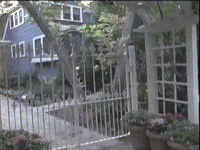Clark Gable and Carole Lombard A California Ranch House for the Stars of Gone With the Wind and Nothing Sacred
Source: Architectural Digest 4/1990 pg 270-271, 312
Text: Charles Lockwood

AS STARS OF the silent film era like Mary Pickford, Douglas Fairbanks, Sr., and Harold Lloyd faded into obscurity in the 1930s after the advent of the talkies, so did the notion that actors and actresses must create flamboyant estates to serve as symbols of their success. The new stars of the 1930s-among them Katharine Hepburn, Gary Cooper, Ronald Colman, Joan Crawford, Cary Grant, Bette Davis and James Stewart-usually lived in handsome but hardly extravagant residences.
Few celebrities exemplified the movie community's shift to simpler lifestyles better than Clark Gable and Carole Lombard. Gable had become one of Hollywood's most successful leading men after winning an Academy Award for Best Actor in Frank Capra's it Happened One Night (1934), then by starring in Mutiny on tjW4 Bounty (1935), San Francisco (1936) and Gone With the Wind (1939). Lombard was a popular leading lady in screwball comedies, who had appeared in films such as No Man of Her Own (1932), twentieth Century (1934), My Man Godfrey (1936) and Nothing Sacred (1937).
Instead of acquiring an impressive state, the couple moved to a twenty acre ranch in the sparsely settled San Fernando Valley town of Encino several months after their marriage in 1939. The property, which included a nine-room house, had belonged to director Raoul Walsh and cost fifty thousand dollars.
At the ranch, Gable and Lombard enjoyed unspoiled country living, far from the tour buses that prowled the streets of Beverly Hills, yet still an easy drive to the studios. To reach the property, they drove through the farmland and small ranches that still characterized the western portion of the San Fernando Valley before World War II. Behind a high fence and an electronically controlled gate, the couple's own property contained acres of citrus groves and fields of oats and alfalfa, stables, a cow barn and a pigless pigsty.
The ranch house, which Carole Lombard had renovated while Gable worked on Gone With the Wind, featured a white-brick-and-wood-frame facade, spacious red-brick terraces and a gambrel roof.

Inside, the rooms were decorated in the Early American style. The living room had canary yellow carpeting and white-painted pine paneling, and was comfortably furnished with Early American-style sofas, quilted wing chairs, green club chairs and a variety of pine tables. The sofas and chairs were oversize to accommodate Clark Gable's large frame. One first-floor bedroom served as his office; another contained his growing collection of firearms.
The second floor comprised adjoining master suites-his decorated in brown and beige, and hers blue and white. Aside from the large his-and-hers dressing rooms, the
obvious sign of Hollywood stardom was Carole Lombard's lavish bath which featured white-marble walls, wraparound mirrors, and crystal and silver fixtures.
Gable and Lombard truly enjoyed their seclusion and country lifestyle. Yet they also knew how to make use of the ranch to enhance Gable down-home image. Studio publicists photographed him mending fence or driving his tractor around the property. During interviews, he often went to the barn with reporters and milked a cow, or helped Lombard gather eggs in the henhouse. For a while, they even discussed the possibility of getting more chickens and selling "The King's Eggs."�
Gable and Lombard's idyllic marriage was sadly short-lived. In 1942 Carole Lombard died in a plane crash as she returned home from a war bond tour. Grief-stricken, Clark Gable enlisted in the air force, and didn't return home to the Encino ranch until his 1944 discharge.
Gable subsequently remarried, but the ranch complemented his personality so genuinely that he lived there until his own death in 1960. In 1973 his widow, Kay Spreckels Gable, sold the property. By then, Los Angeles had completely engulfed the once rural area, and though the house survived, the ranch was subdivided in an expensive housing development called the Gable Estates.
|
